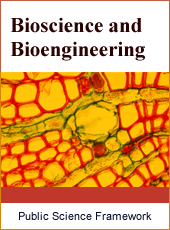Bioscience and Bioengineering
Articles Information
Bioscience and Bioengineering, Vol.3, No.2, Apr. 2017, Pub. Date: Sep. 27, 2017
A Vast Aquatic Diversity Reveals the Richness of Bagmati Biodiversity
Pages: 11-16 Views: 3007 Downloads: 1071
[01]
Kripa Ram Mehta, Department of Zoology, Trichandra Multiple Campus, Tribhuvan University, Ghantaghar, Kathmandu, Nepal.
[02]
Ujjawal Kumar Singh Kushwaha, Agriculture Botany Division, Nepal Agricultural Research Council, Khumaltar, Lalitpur, Nepal.
Bagmati is a holy river of Nepal which flows through Kathmandu valley. It has both religious and social value. An assessment was conducted in 2011/12 that showed richness of aquatic biodiversity of Bagmati. The level of flora and fauna also indicated the level of pollution of water. Many bacteria, fungi, aquatic protozoans, fish, and algai were present. Thus there is urgent to address the river to conserve its aquatic biodiversity. It needs to carefully regulate and control human activities, resource use, and waste disposal in order to improve the water quality in the Baghmati. This can best be accomplished in conjunction with improved environment planning and control and inter-sectoral coordination at national, and local levels.
Zooplankton, Phytoplankton, Protozoans, Algae and Fungi, Diatoms, Macro Invertebrates
[01]
Chaube U. C., Sharma, S., Sharma, P. & Kumar, P. (2008). Water quality assessment of river Satluj using benthic macroinvertebrates. Proceedings of the Scientific Conference, Rivers in the Hindukush–Himalaya-Ecology and Environmental Assessment.1: 77-83.
[02]
ENPHO (1996, b). Environment and Public Health Organization. Report on the Water Source Monitoring Program for the Shivapuri Watershed by Assessing Water Quality (First Phase). Kathmandu: ENPHO.
[03]
FPAN-DISVI (1988). Pollution monitoring of Bagmati River, preliminary report. FPAN-DISVI project, Kathmandu, Nepal,
[04]
Gyawali D. (2001). Water in Nepal published by Himalyan Books and south Asia with Nepal. Water Conservation Foundation. Kathmandu, Nepal.
[05]
Hartmann, A., & Moog, O. (2008). Development of a field screening methodology to evaluate the ecological status of the streams in the HKH Region. Proceedings of the Scientific Conference, Rivers in the Hindukush–Himalaya-Ecology and Environmental Assessment 1:17-24.
[06]
HMGN/JICA (2005). The study on the Solid Waste Management for the Kathmandu Valley. Annual Report, 2005.
[07]
Macan, T. T. (1974). Freshwater ecology. John Wiley and Sons, New York. pp. 343.
[08]
Moog, O. and Sharma S. (1996): Biological rapid field assessment of water quality in the Bagmati River and its tributaries, Kathmandu valley, Nepal. Proceedings of the Ecohydrology Conference on High Mountain Areas, March 23-26, 1996, Kathmandu, Nepal, pp. 609-621.
[09]
NPC/IUCN (1991). Nepal, Environmental pollution. In Nepal – A Review of Studies, National Conservation Strategy Implementation Programme, National Planning Commission, HMG, Nepal, in collaboration with IUCN. The World Conservation Union. pp. 40.
[10]
Paudel A. (1998). Bagmati River Water Quality Management: problems and constraints, paper presented in a seminar organized by the Department of Water Supply and Sewerage, Society of Public Health Engineers Nepal, UNICEF Nepal and World Health Organization held on 22 - 23 March, 1998 in Kathmandu, Nepal.
[11]
Pradhan, B. (1998). Water Quality Assessment of the Bagmati River and its Tributaries, Kathmandu Valley, Nepal. Ph.D. Thesis. Vienna: Department of Hydrobiology, Institute of Water Provision, Water Ecology and Waste Management, BOKU.
[12]
Rajbanshi, K. G. (1982). General bibliography of fish and fisheries of Nepal, Royal Nepal Academy, Kathmandu, Nepal. pp11.
[13]
Sharma, C. K. (1977). River system of Nepal. Published by Sangeeta Sharma, Kathmandu, Nepal, pp. 1-224.
[14]
Tuladhar B.; Van den Berg, S. R.; Ban, A. (1998). Assessment of Waste Recycling Technologies in Nepal. Kathmandu: National Council for Science and Technology, Kathmandu, Nepal.
[15]
Upadhyaya, N. N. Roy. (1982). Studies on river pollution in Kathmandu Valley. Indian J Environ Hlth. 24:124-135.

ISSN Print: 2381-7690
ISSN Online: 2381-7704
Current Issue:
Vol. 6, Issue 3, September Submit a Manuscript Join Editorial Board Join Reviewer Team
ISSN Online: 2381-7704
Current Issue:
Vol. 6, Issue 3, September Submit a Manuscript Join Editorial Board Join Reviewer Team
| About This Journal |
| All Issues |
| Open Access |
| Indexing |
| Payment Information |
| Author Guidelines |
| Review Process |
| Publication Ethics |
| Editorial Board |
| Peer Reviewers |


